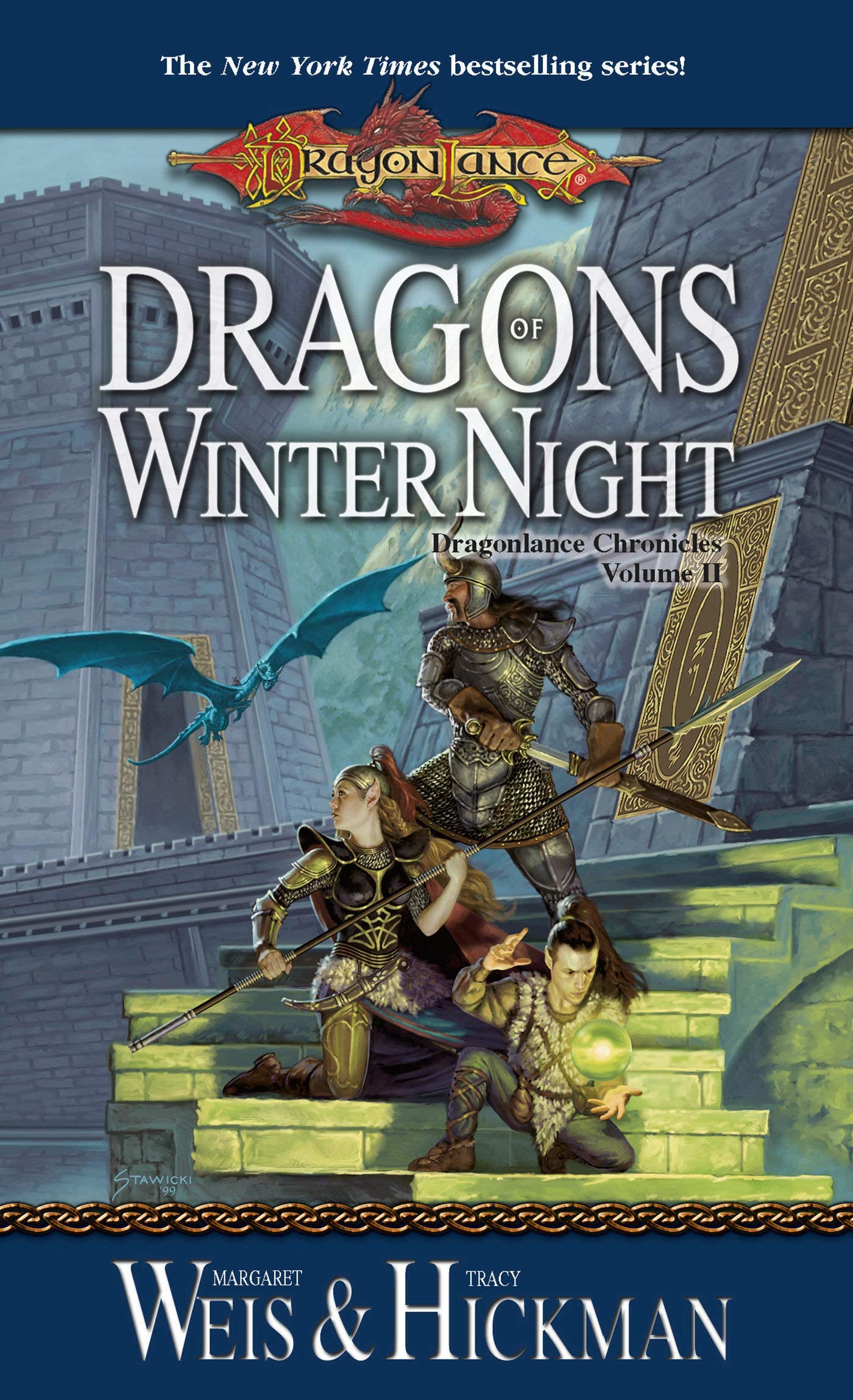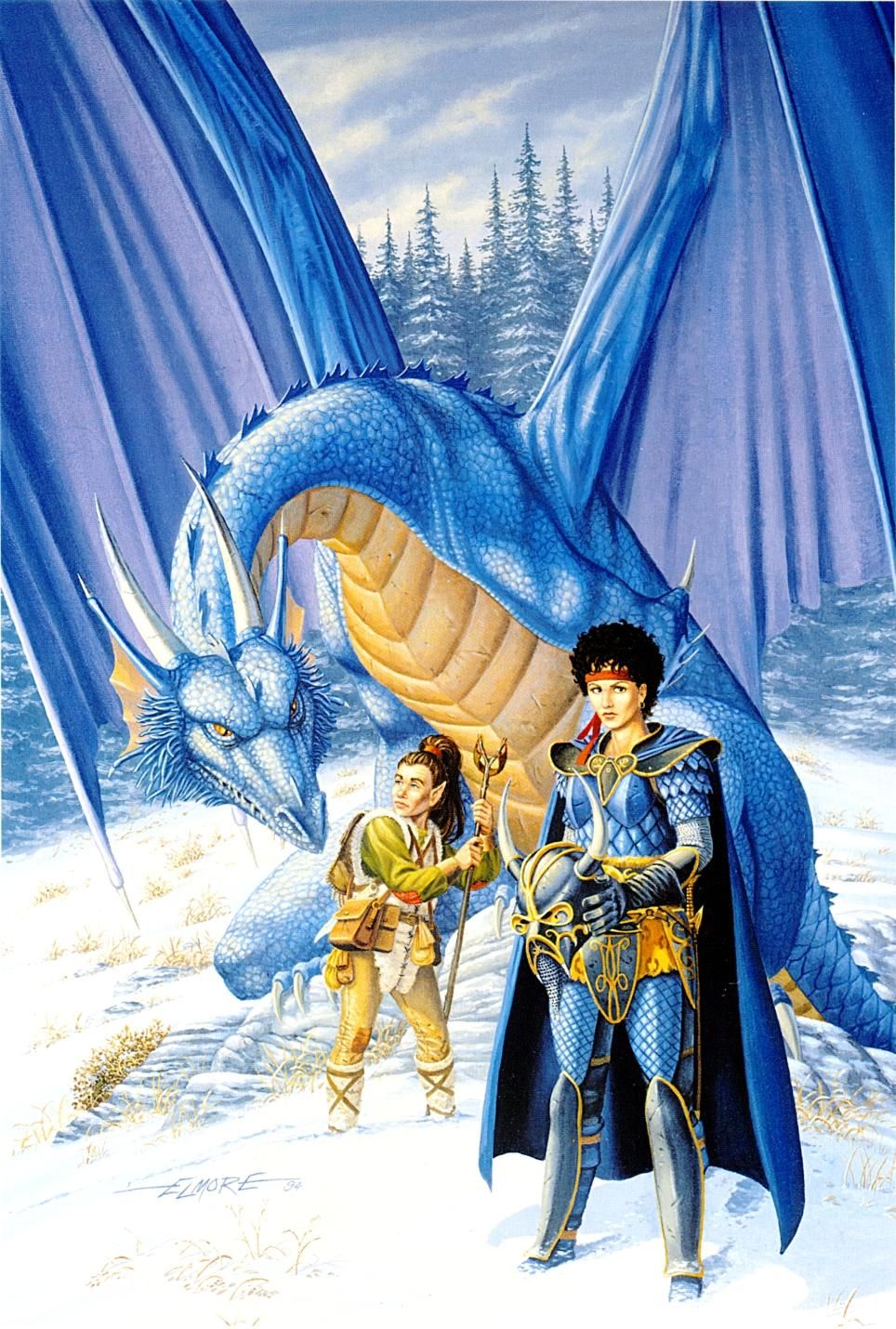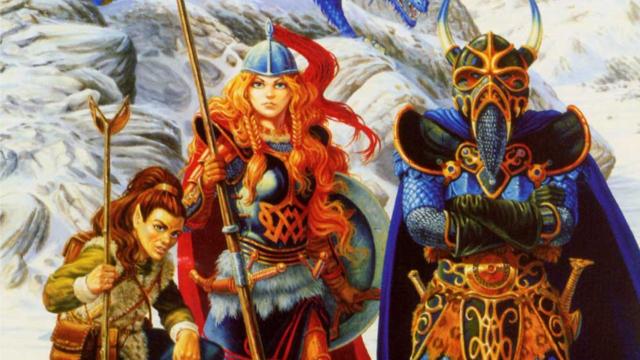Upon finishing Dragons of Winter Night, the second book in Margaret Weis and Tracy Hickman’s beloved first Dragonlance series, I realised I had a problem: I didn’t know what it was about. Or rather, I don’t know what it isn’t about. So many characters are added, so many new plots are begun, and giant detours are taken from the story I thought the trilogy was telling, that it’s a mess. So why is Dragons of Winter Night still good?
If you haven’t read the first Dragonlance trilogy in a while, you might remember the second volume as continuing the adventures of the Dragons of Autumn Twilight party of Tanis Half-Elven, the moody knight Sturm, the elven princess Laurana, the barbarian cleric Goldmoon, her guardian and husband Riverwind, the always-presumed-evil mage Raistlin and his beefy twin brother Caramon, Flint the Dwarf, Tika the ex-barmaid, and Tasslehoff Burrfoot. You would be technically correct! But the book is also about Laurana’s brother Gilthanas, the cleric Elistan, and an arsehole knight named Derek who hates the hell out of Sturm for some reason. Oh, and then there’s a wild elf named Sylvana and then Raistlin and Caramon’s older sister Kitiara. And many of these new characters have more “screentime” than some of the first book’s heroes.
It was confounding at first and then confounding for a while longer as new storylines kept piling up around them. But eventually, I realised it was amplifying the quality that I’d found so compelling in Autumn Twilight. Weis and Hickman make Krynn feel like a living world. While Tanis and Raistlin are battling nightmare dragons in the twisted land of Silvanesti, Laurana and her crew find a legendary Dragon Orb, the two races of elves are trying to decide if the return of the dragons is somehow humanity’s fault and should be abandoned to their fate, while the Knights of Solamnia are reduced to political bickering, rendered impotent to fight the greatest threat to Krynn since… well, the last time the goddess Queen Takhisis and her minions arrived. It’s certainly messy, but the setting and the story are both far richer for it.
All these people and events affect the characters’ journeys in ways both interesting and surprising. Additionally, the authors split the party very early, downsizing the groups to allow for more character interactions and enriching their relationships better than the first novel did. Weis and Hickman’s ability to keep juggling their myriad storylines reminded me of George R.R. Martin’s A Song of Ice and Fire series. It’s not done as skillfully as Martin, but we can cut Weis and Hickman some slack given Winter Night was their second novel ever, published in 1985.

The character best served by Winter Night is unequivocally Laurana, who arrived in the first book as a completely naïve, lovestruck elf princess chasing after Tanis. Over the course of the second volume, she becomes the leader of her half of the party, kicking arse, taking names, giving genuinely rousing battle speeches, and not fainting dead away when Tanis’ ex-girlfriend Kitiara shows up as a Dragon Highlord and taunts her that Tanis has joined the bad guys. It’s all very satisfying. It’s also satisfying for Sturm to have things to do in addition to brooding, such as when he’s unwillingly caught in the political machinations of the Knights and forced to watch Derek lead most of them away in a failed suicide charge against the armies of Takhisis. Then he has to lead his few remaining soldiers to hold a tower against three blue dragons and a High Lord. Those who remember the novel probably also remember how shocking this battle is and how it ends, and damned if that didn’t hold up, despite the fact that almost none of it was set up in the first book.
But that’s true of a lot of things! The Dragon Orbs, which are literally introduced in this novel as powerful magical artifacts no one’s bothered to tell us about previously, are the focus of most of the story. Yet after a wild, shared nightmare of horrors — dreamed by the entire “main” party — that involves almost all of their horrific deaths, Raistlin defeats a green dragon in some totally opaque scene where he bargains with a thing to gain… something, which nets him an Orb. Then Laurana literally gets another one, as well as defeats a Dragon Highlord, in-between chapters! Then Tasslehoff breaks one during a world council to make a point and unite the elves, humans, dwarves, and gnomes against the forces of Takhisis. The Orbs are mere MacGuffins to seemingly be thrown away after Winter Night, but they still all serve such a clear purpose in the story I can’t find myself unsatisfied.
The Dragonlances, which also make their first appearance in this volume, are a different story. Somehow, they are bestowed on the heroes even more randomly and haphazardly than in The Legend of Huma, where they already felt like an afterthought. But at least in the prequel about the legendary hero, he and his army used them for aerial dragon jousting, the hallmark of Dragonlance — here they’re just used to poke at trapped dragons once they’re summoned by one of the orbs. Only the bad guys have dragons to ride on. (At the moment, at least.)
There are so many plot threads that not all of them tie off neatly, and even if they are continued in the sequel Dragons of Spring Dawning, it’s hard to imagine they’ll all be well-woven. And the Dragonlances need to become even marginally cool if the trilogy’s going to work as a whole. But damned if Winter Night doesn’t still transcend so many of its flaws, I can’t help but rank it only slightly below Dragons of Autumn Twilight. It’s messier but far more ambitious, and even if character growth suffers (minus Laurana) the character development feels richer, even if it’s just because they aren’t sitting around hating each other all time. That means Dragons of Winter Night rolls a 17 on its 1d20 — but since it doesn’t have the -2 penalty for focusing so much on gully dwarves, this means it’s a point higher than its predecessor. I honestly can’t imagine how or even if Dragons of Spring Dawning manages to tie this all together but I’m eager to find out. When D&D&N returns, we’ll conclude the trilogy!

Assorted Musings:
- I finished this book last night and I cannot remember anything Goldmoon, Riverwind, or Tika did. The only thing I remember Caramon doing is taking care of Raistlin and refusing to have sex with Tika.
- Lest you think the self-hatred was all gone, here’s a bit of Tanis’ interior monologue: “The sight of their faith in him infuriated the half-elf.” For the record, Laurana has self-doubts, but no self-loathing, and it’s much more endearing.
- Just as when I was a child, I truly do not know what happened when Raistlin made his pact during the green dragon’s dream attack, nor do I understand what happened when he got his hands on the Dragon Orb. I have to assume this will be paid off in Spring Dawning.
- Laurana’s dad nearly calls her a “human whore” for chasing after Tanis in Autumn Twilight and that’s the point she says fuck ‘em and takes full charge of the mission to save the world.
- The Dragon Ball manga (and later its hit anime) was created in 1984, the same year as Dragons of Autumn Twilight, but a year before Winter Night. Given the total lack of Dragon Ball presence in the U.S. at the time, I feel safe saying the Dragon Orbs are the result of concurrent thinking.
- I won’t go into details, but The Legend of Huma feels much, much, much less original if you read this trilogy before the prequel.
- Fizban, the completely bonkers but extremely powerful wizard who died in Autumn Twilight, is back and expresses his hopes that he had a “21-gun salute” at his funeral. Everyone around him: “Uh, what are guns?”
- Speaking of confusion, I’d utterly forgotten the man with the green gem in his chest existed because he shows up so late in Autumn Twilight and does almost nothing. Then he pops up for like half a page in Winter Night and later Kitiara says he’s the key to allowing Takhisis to take over the world. I have no idea what they’re talking about or why he’s important or why we still know absolutely nothing about him after 66% of the story had been told. We’ll see, I guess…?
